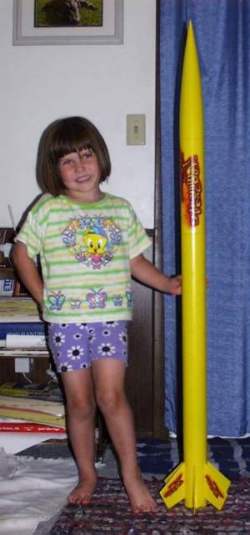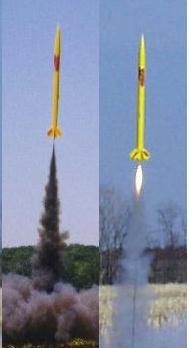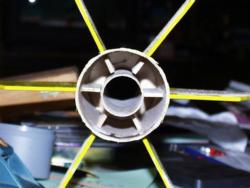| Manufacturer: | Rocket R&D |

(Contributed - by Chip Jenkins)
 Brief:
Brief:
A six-finned, mid-body rocket with a 28" diameter parachute.
Construction:
The packaging was in a bag (standard), all of the parts were included, no
broken or missing pieces. The kit included body tubes made from heavy
cardboard, a plastic nose cone, and six high quality plywood fins. The body
tube was pre marked and easy to slot with a sharp hobby knife. It was very easy
to assemble with 2 ton epoxy.
The only complaint was that the fins were not long enough to reach the engine tube from the body tube. I thought (for an instant) about altering the fins to allow them to reach the engine tube but, I didn't. The epoxy was strong enough to hold all six fins. The six fins were the main reason that I chose the Peacock.
The recovery system has a steel cable that is attached to the plywood centering ring and goes up to near the top of the lower section of the body tube. Then, a 9 foot shock cord is tied to the end of the cable. If I were to do it again, I would have done something to secure the loose end of the cable (near the loop at the end) because it sometimes catches the nylon parachute. In my opinion, a great kit!!
Finishing:
I did wash and sand the plastic nose cone prior to spraying the primer. I also
brushed on some sanding sealer (a few times) and rounded the leading edge of
the fins. When done, I ended up with nice, smooth fins. There were no decals
included, so I looked to the Internet for a picture of a peacock that seemed
appropriate. It took just a few minutes until I found the perfect decal image
on the Internet. Then, with some decal paper, I adjusted the color of the image
and printed it. Two cans of sun yellow paint and then I applied decals (should
have made them a little smaller) and the "Screaming Peacock" was
complete
Construction Rating: 4 out of 5
 Flight:
Flight:
Motors recommended are F25-6, F50-6, F80-5, G25-5, G40-7, G80-7, H55-10,
H120-10. I flew it once (so far) using a North Coast Dark Star F62-4. I tried
to get a picture with the digital camera but, I took off too fast. I mean it
really lifted off the pad. I wish it had a piston ejection system, barring
that, I sewed some Nomex® cloth together and tied it to the shock cord. I should
have tied it a little better though, lost the Nomex® on the first flight. It
protected the parachute just fine though. The flight was flawless, straight
(probably due to the six fin design). I cant wait to put a H128 motor in this
thing for my level 1 certification.
April 2000:, I flew it with an F-40 at a club launch. The Peacock has a
slow descent rate so, I shortened the parachute cords somewhat with some
tape and let her fly. The flight seemed perfect, I received complements
from some of the other flyers after I retrieved it. But, as I mentioned
before, the TTW fins didn't quite reach the motor tube. That fact,
coupled with the somewhat faster descent, cracked the epoxy joint on one
of the fins. So, I figured it was time to kill two birds at once. I
used a dremel to cut the rear centering ring off to reveal the
underlying fins.  As you can see in the picture, there is close to 1/8"
gap between the root edge and the motor tube. I bought some system
three epoxy and filled the gaps, and filleted the internal joints
between the airframe and the fins. Now, the connections are strong.
Then, before I glued a new centering ring back in, I added two 4-40
blind tee nuts. I don't know if the short fins were an oversight by
Rocket R&D or not but, if anyone else runs into the same problem,
definitely fix it before installing the rear centering ring. (Rocket
Dog is in the launch picture and I assure everyone that the dog loves
launches and has never been harmed).
As you can see in the picture, there is close to 1/8"
gap between the root edge and the motor tube. I bought some system
three epoxy and filled the gaps, and filleted the internal joints
between the airframe and the fins. Now, the connections are strong.
Then, before I glued a new centering ring back in, I added two 4-40
blind tee nuts. I don't know if the short fins were an oversight by
Rocket R&D or not but, if anyone else runs into the same problem,
definitely fix it before installing the rear centering ring. (Rocket
Dog is in the launch picture and I assure everyone that the dog loves
launches and has never been harmed).
Recovery:
The 28" parachute worked perfectly, and brought it down easy for a safe
recovery (in the middle of some high grass) .
Flight Rating: 5 out of 5
Summary:
This rocket is easily my favorite one. The excellent construction materials
along with the ease of assembly makes this kit stand above any other ones that
I have constructed. If this kit is characteristic of other Rocket R&D kits,
I would recommend any of them to rocketeers interested in a quality product.
This kit would have merited 5 out of 5 overall if the fins reached the engine tube and if the frayed end of the cable had been secured so that it did not snag on the parachute.
Overall Rating: 4 out of 5
Sponsored Ads
 |
 |











